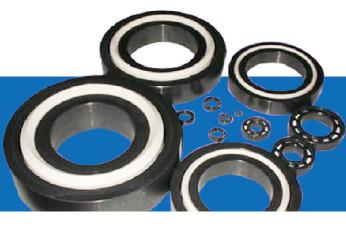Industrial Ceramic Parts Ceramic Bearings
Silicon oxide full ceramic bearings
The rings and rolling elements of silicon hydride full ceramic
bearings are made of silicon hydride (SI3N4) ceramic material, and
the retainer uses polytetrafluoroethylene (PTFF) as standard
configuration. Generally, GRPA66-25, PEEK, and bakelite can also be
used. Compared with Zr02 material, SI3N4 full ceramic bearings can
be used for higher speeds and load capacities, and are suitable for
higher ambient temperatures. At the same time, precision ceramic
bearings for high-speed, high-precision, and high-rigidity bearings
can be provided, with the highest manufacturing accuracy reaching
P4 to UP level.
Oxide full ceramic bearings
The rings and rolling elements are made of oxide (Zr02) ceramic
material, and the retainer uses polytetrafluoroethylene (PTFF) as
standard configuration. Generally, glass fiber reinforced nylon
(GRPA66-25), special engineering plastics (PEEK I PI), stainless
steel (ALSI SUS316, SUS304), brass (cu), etc. can also be used.
Full-filled all-ceramic bearings
Full-filled all-ceramic bearings have a gap for adding balls on one
side. Because of the cage-free design, more ceramic balls can be
loaded than standard bearings, thereby improving the load capacity
in the diameter direction. In addition, the restrictions on the
cage material can be avoided, and the corrosion and temperature
resistance of ceramic cage-type all-ceramic bearings can be
achieved. This series of bearings is not suitable for high speeds.
When installing, it should be noted that the gap surface is
installed on the end that does not bear the radial load. Because
the inner and outer rings of the bearing have a gap for adding
balls, it is not suitable for applications with large radial loads.
Ceramic cage all-ceramic bearings
Ceramic cages have the advantages of wear resistance, high
strength, corrosion resistance and self-lubrication. All-ceramic
bearings made of ceramic cages can be used in harsh environments
such as extremely strong corrosion, ultra-high and low temperatures
and high vacuum. The commonly used cage ceramic material is Zr02.
Hybrid Ceramic Ball Bearings
Ceramic balls, especially hydride silicon balls, have the
characteristics of low density, high hardness, low friction
coefficient, non-magnetic and electrical insulation, wear
resistance, self-lubrication and good rigidity. They are
particularly suitable for high-speed, high-precision and long-life
hybrid ceramic ball bearings (inner and outer parts are metal).
Generally, the inner and outer parts are made of bearing steel
(GCrlS) or stainless steel (ALS1440C, 316 304), and ceramic balls
can be made of Zr02, Si3N4, or SiC materials.










